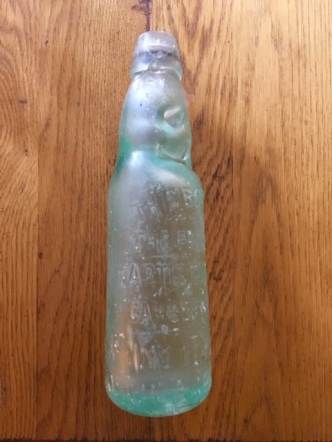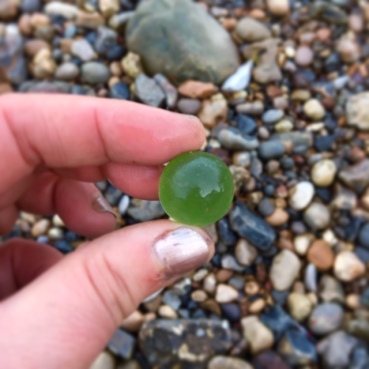Extra low tides so far this year have meant the chance to wade further out into the Thames mud than usual and find items that are normally just out of reach. So it was doubly thrilling to start January with a complete Victorian Codd Bottle find, and February with a vintage Bovril bottle. Well, exciting for me, but maybe not so much for the non-mudlark who doesn’t quite get the passion for finding lovely, muddy things on the Thames Foreshore when the tide is out.

This rare Artis, Capel and Company codd bottle was found by me on the Rotherhithe foreshore. It was mostly buried underneath what had once been a chalk barge bed and it took some while to gently ease it out of the chalk and mud with my trusty trowel. That done, it was a delight to find especially as it was intact and with its codd bottle marble still inside. Cleaning it was a heck of a task but was well worth it.
Artis, Capel and Company, the manufacturers of this bottle, were a Surrey Mineral Water Company based in Neate Street, Camberwell, SE London. Their business was founded in 1864 at a time when carbonated drinks were becoming increasingly popular but keeping the fizz in the bottle was proving to be a huge challenge.
In 1870, Hiram Codd invented and later patented the famous Codd bottle which made a huge difference to drinks companies producing these carbonated drinks. The bottle was made from thick, aqua green glass and contained a codd marble inside that helped keep the fizz in when the bottle was placed on its side. The design was a huge favourite with Victorian children who would smash the bottle to get at the marble. This is why complete versions of these bottles are hard to find. The photograph below shows an emerald green Codd bottle marble found by me on a previous mudlark at Rotherhithe, not far from where the bottle find was made.

My Codd bottle has a dent on both sides called a ‘lug’, which keeps the marble (above) wedged in. The bottle is inscribed with a rare Rylands of Barnsley patent on one side and the following words on the front:
‘THIS BOTTLE IS THE PROPERTY OF ARTIS, CAPEL & Co, CAMBERWELL. NO DEPOSIT CHARGED.”
Artis, Capel and Company were eventually taken over by Robert White (R White & Sons fizzy drinks manufacturers, still producing lemonade today). In 1912, two hundred women went on strike at the R White factory at Waltham Cross, protesting over the reinstatement of an unpopular supervisor. All power to these ladies!

A second extra low tide in February, where I hadn’t actually found very much when mudlarking, saw me rolling off the Thames Foreshore in the City of London just as the tide was starting to come back in. Glancing down into a rock pool I saw this Bovril bottle lying in the water.

It’s a vintage style from 1913, 2oz in weight, classic dark amber in colour, the bottle inscribed with the words ‘Bovril Limited’. These also came in a 4oz size. A classic example of the ‘What The Victorians Threw Away’ genre, Bovril quickly became a very popular food item. It’s still popular today, although you either love it or hate it, and is now rebranded as ‘Marmite.’
Invented by John Lawson Johnston, a Scottish butcher who hailed from Roslin (made infamous in Dan Brown’s novel ‘The Da Vinci Code’,) Johnston went to Canada where in 1863 he devised a recipe for a liquid beef broth which he called by the catchy name of ‘Johnston’s Fluid Beef.’ In 1874 he won a huge contract from the French Government to supply the French army with one million tins of beef, enabling him to experiment further with the offcuts and refine his liquid beef product to make it more concentrated. In 1879 he moved production to Montreal where he began to sell his beef broth warm during the winter carnivals.
After a fire, he returned to Shoreditch in London and in 1887 registered the name ‘Bovril.’ In 1888 the iconic brown Bovril bottles were introduced and production moved to 30, Farringdon Street. A popular advertising campaign followed with brightly coloured posters publicising this product to the public. Below is one of these, currently part of the extensive Victoria and Albert Museum archive.

The first Bovril bottles manufactured in the late 1880s were initially hand made. My bottle find is from 1913, just prior to the outbreak of World War One, when bottle production became automated for the first time although the neck and lip continued to be hand finished, as you can see from the photos below. On the right, there’s a clearly visible seam that runs along the neck down to the bulbous body of the bottle and, on the left, the thick, irregular shape of the lip.
These early bottles are reassuringly chunky with a dent at the base indicating their pre-war age, a design factor that continued into the 1920s as there was a shortage of glass. Inevitably my Bovril bottle research pulled me into a bit of an internet black hole of vintage Bovril bottle geekery. I discovered a site where fans happily discuss the fact that there are 35 different types of Bovril bottle, further breaking them down into 50 sub types. At this point I quietly crept away….
John Lawson Johnston became a very wealthy man as a result of his Bovril manufacture and in 1891 bought Kingswood House in Southwark. He transformed the building adding battlements and a north wing, plus extending the servants’ quarters. His extensive renovation resulted in the house being nicknamed ‘Bovril Castle.’ When he died in 1900, the house was used as a military hospital for wounded Canadian soldiers from the first world war. Eventually the Johnston Estate was sold in 1919 to Sir William Vestey, Lord Vestey of the Vestey Meat family. John Lawson Johnston was buried in Norwood Cemetery in London.
The Vesteys went on to purchase Oxo Tower Wharf, on the south bank of the River Thames, from the Leibig Extract of Meat Company, manufacturers of Oxo beef stock cubes, who had designed the original Oxo Tower so as to bypass advertising bans that existed on the south bank at that time. The illuminated tower advertising the Oxo product could be seen quite some distance away. Unfortunately, on an early morning February mudlark when I took this photo below, the lights of the Oxo Tower (just in front of the hideous tower block known as One Blackfriars) had well and truly gone out…..



Expect I’m not the first sandwich spread pedant to point out that Bovril and Marmite are different things. Marmite is made of yeast, not beef, so is beloved by vegetarians and vegans!
LikeLike
You are absolutely correct -:)
LikeLike